No products in the cart.
The Council for the Indian School Certificate Examinations (CISCE) has recently been seen to take up the revolutionary change in its evaluation system, shifting from mere rote learning to competency-based assessments. This new-age approach not only leads students to deeper understanding but also to success in practical and real-world scenarios.
With this academic year, the competency-based questions weightage will increase from 25% to 40% in ICSE and ISC examinations. This is a matter of rethinking traditional approaches to teaching in favor of a more critical thinking, problem-solving, and holistic approach to learning.
Preparing for Transition: Why it Matters.
As principals and school leaders, the shift toward competency-based learning presents an opportunity to enhance both teaching methodologies and student outcomes. Schools must align their curricula to ensure students can meet these new challenges effectively. Beyond academic success, this approach equips students with essential life skills, setting them up for long-term success in higher education and careers.
How QuestPlus Can Help
QuestPlus provides a smooth way for schools to adapt to this new educational scenario. Built with competency-based learning, QuestPlus provides tools specifically suited to meet the needs of CISCE's new set of requirements:
With these, QuestPlus enables the principal to effectively lead the transition process so that teachers can teach in the most impactful way and make the students perform better with this new assessment framework.
Future-Ready Students, Efficient Teaching
Through integration with QuestPlus, students will be ready not only for the exams but also for future challenges. This platform makes teaching easier and, therefore, focuses on nurturing students' potential.
Now is the time to invest in solutions that support progressive education. Let QuestPlus help your school navigate this transition smoothly, improve efficiency, and ensure students thrive in the competency-based learning model.
Reach out today to learn how QuestPlus can partner with your school to shape future-ready learners.
As educational technology advances, Mumbai schools are undergoing rapid transformations. Chalkboards, textbooks, and traditional learning methods are things of the past because digital tools and platforms have taken centre stage in the classroom. Today, classrooms are adopting a blended approach, and technology is supplementing traditional forms of teaching to bring dynamic and interactive learning experiences to students. In this write-up, we will learn how EdTech is modifying education in Mumbai schools, the key benefits of integrating digital solutions with the curriculum, and, most importantly, how platforms such as Singhania Quest+ help in this process.
EdTech solutions like Singhania Quest+ facilitate self-paced learning for students. Every student is a unique learner with strengths and weaknesses. Digital learning platforms can then be leveraged to adapt education content based on the learner's individual needs, hence not allowing any student to get bored or lag in material that is too easy for him. For instance, Singhania Quest+ offers various tools to academics through which differentiated learning is facilitated, and every child is challenged adequately.

Traditional learning methods struggle to keep students attentive. EdTech, in contrast, brings multimedia and interactive content to classrooms, making learning interesting and relatable. The Singhania Quest+ Integrated Coding Platform, among other things, provides access to coding exercises and engaging lessons where students learn theory and apply concepts in real-life situations for better retention of ideas.
One of the biggest strengths of EdTech is access to unlimited resources. Through Singhania Quest+, all students who study in schools in Mumbai have unlimited access to vast amounts of online learning resources, videos, quizzes, and modules. This reduces inequality by giving every learner scope to learn and develop through the best resources available.
The assessment process through EdTech platforms has changed. Using facilities such as Singhania Quest+ Question Paper Generator, a QPG tool, teachers can quickly produce assessments, share these assessments with the students, and provide immediate feedback about performance since this is a facility in the digital sphere. These make the students learn continuously and even spare their teachers from heavy paperwork so that they have the time to focus on something more substantial.
Modern education is no longer bookish. The EdTech platforms, including Singhania Quest+, also have career counselling and professional development tools to help the child identify his strengths and choose the right career stream. Schools in Mumbai are now incorporating such tools to ensure that students are prepared for exams and life. This equips the students with a holistic preparation for life after school.
Singhania Quest+ appears to be a well-rounded school programme that requires digitisation involved in work. The lessons are taken from classroom-based teaching up to the level of analytical evaluation and, most importantly, for trainers of the teachers and a completely integrated school ERP systems. Singhania Quest+ is one solution to cater to any schooling institute with an arrangement for amending its teaching process and classroom style methodology, which yields an optimum outlay of class sessions.
1. Academic Learning Platform
Academic Learning Platform is provided under Singhania Quest+, keeping the learning resources neatly formatted and updated. This enables the schools of Mumbai to acquire new and better teaching skills that might enhance the application of technology. The tools allow efficient teaching with an emphasis on learning for the students, with the tools consisting of lesson plans, quizzes, and more digital material used by the teachers to create an interactive component of the lessons.
2. Teachers' Evaluation Tools for Schools
Assessments and grading are time-consuming activities for teachers. Singhania Quest+ has made this whole process easier by offering assessment tools that allow teachers to design tests, track performance, and analyse trends and student performance. These are very time-saving aspects that give teachers valuable insights to identify and help their students in areas needing support.
3. Built-in Coding Platform
Coding will be a skill for tomorrow, and Singhania Quest+ offers an Integrated Coding Platform to help students achieve their coding skills from the beginning. When learning to code is included in curricula in schools, there is a lot more students learn beyond just the technical skill. They learn a lot about problem-solving ability, logical thinking, and creativity, all important skills needed in today's world.
4. School ERP Systems
Managing school operations is quite an intricate affair; however, the School ERP systems by Singhania Quest+ ensure everything from student records to attendance, fee collection, and even communication with parents can be managed in a way that does not add to their administrative burden so that the schools can concentrate more on improving the quality of education.
Integrating EdTech in Mumbai schools is no longer a luxury—it's a necessity. The Singhania Quest+ is one of the leading platforms that offers tools to enhance teaching, personalise learning, and ensure holistic development for students. Technology will shape the future of learning in Mumbai as the education system evolves. Schools that embrace change will see their students improve academically and better prepare them for future challenges and opportunities.
Coding is the new skill all people must acquire in this high-paced, technology-driven world. From problem-solving to critical thinking, it is the ability to revolutionize education in schools. Not only will it allow for technical abilities that are going to be used in the future job market, but it also will cultivate their creativity and innovation skills.
Well, with the recent emergence of coding camps and online resources, learning to code has never been so accessible for students. They can now advance their coding skills at their own pace, quite away from the confines of the traditional classroom environment. As the field advances through platforms offering interactive technologies along with gamified learning experiences, learning to code also becomes an exciting subject of study for any age group.
Moreover, coding encourages teamwork and collaboration by developing communication and project management skills. Students can collaborate on coding projects and help each other troubleshoot and debug their code. This collaborative approach to learning not only enhances their skills at coding but also readies them for real-world career scenarios.
As schools embrace the power of coding, they equip their students to be creators and problem solvers for the future of technology and innovation. It is through this innovation that schools can feasibly incorporate coding into the education process by filling in the gaps necessary to make great producers for the digital age
Coding is no longer just a technical skill but a kind of literacy that underpins so many aspects of current life. As technology reaches every sector, the ability to know how code works empowers one to engage meaningfully with the devices and systems governing their surroundings-from mobile telephones, to smart homes-being able to understand how the technologies work has opened vistas for creativity and adaptability. This foundational knowledge is important for a world increasingly shaped by digital interactions and automated processes.
In addition, programming encourages a problem-solving and logical approach. In the learning process of how to code, students become a structured vehicle of thought in the provision of high-level problem-solving skills. The skills acquired through coding— such as algorithmic thinking and debugging—are portable and sharply improve performance in many domains, including maths and science. This is a reason in itself why this type of cognitive development is very important because technical skills are no longer the only thing job markets require but critical thinking as well, which often occurs through writing code.
Thirdly, the pool of workers who require coding skills is increasing. With rapid technological advancements, industries are changing daily; employers look for candidates who are not only proficient but extremely capable in coding. Some fields wherein a strong grasp of codes is required include software development, data analysis, artificial intelligence, and cybersecurity. Bringing coding education into schools will prepare students for futures in which they are consumers of technology as well as contributors in its making and advancement
There are numerous benefits to teaching coding in schools: technical skills are only one of the advantages. Among the most significant benefits, students will gain improved creativity. Coding also makes it easier for people to think outside the box and try to accomplish different things. When students learn to code, they do not just stick to instructions. Instead, they are producing their own projects-whatever that may be-be it something as simple as a game or something as complex as an application.
This creativity leads to innovation and fosters a sense of ownership over the learning product.
Coding education also teaches collaboration and teamwork. Many coding projects are group projects where ideas are shared, problems are solved together, and learned from each other. This is closely similar to what happens in the real world where collaboration and teamwork greatly guarantee success. By engaging their students in coding group activities, more than their skills is sharpened; they also learn to have communication, run projects effectively, and appreciate differences.
However, introducing coding in schools is also equipping the students with solid skills for the future. As technology continues to reshape industries, an understanding of coding becomes increasingly integral in this era. Students who learn to code get intuitive knowledge about how technology functions, thereby enhancing employability in a job market dominated by technology. Incorporation of coding into the framework of education enables the students to be co-architects of the future and not merely passive consumers of technology.
Adding coding in schools is a matter of integration, thus requiring so much careful planning and thinking. The first step would be to identify how coding relates to the pre-existing subjects. For example, coding can be used as an add-on to math in terms of algorithmic thinking or to use as an application of science through simulations and data analysis. Bringing it into the fold of different subjects will allow educators to show its relevance and its utility from a multidisciplinary perspective, thereby making it a crucial aspect of learning.
In addition, school teachers should make sure that coding is not a separate subject, but part of a new entire system in teaching students. This can be very effectively accomplished through interdisciplinary projects in real-life contexts applied through coding. Some examples could be developing a digital story because it combines coding and language arts, or a program for modeling a scientific phenomenon. Such projects not only enhance engagement but also offer a deeper understanding of both coding and what is being dealt with.
Professional development of the teachers is another important element that ensures the appropriate incorporation of coding within the curriculum. Teachers must feel confident that they can successfully deliver coding concepts to students. Training, resources, and support are imperative elements required for teachers. Proper curriculum content preparation among educators by offering continuous learning creates a culture for schools to ensure high quality in the instruction of coding and provides teachers with the means to teach students inspiringly in this subject area.
In fact, there is an arsenal of tools and resources that are making coding in the classroom accessible to students than ever before. Among the more popular ones is Scratch, a visual programming language designed for young learners specifically. The medium allows students to drag and drop code blocks together in order to create interactive stories, games, and animations-this makes the complex work of coding much easier and enjoyable for students.
Code.org is also a good resource-it does really have an awfully vast curriculum for teaching coding, and then goes to various grade levels. It has interactive lessons, tutorials, and activities meant to make it conducive for teachers as well as the students. It helps educators build an organized coding curriculum that favors different styles of learning and the flexibility of the pace.
Besides these platforms, online communities and forums have been utilized to connect with other teachers and share best practices. Online communities like GitHub and Stack Overflow help educators access information and partner up with others. Moreover, coding competitions and hackathons are meant to apply what is learned in an environment that is fun and competitive, which hoorays coding as a hobby.
There are obvious advantages to coding education, but there are challenges to be considered in terms of its design and implementation in the school system. The most significant barrier relates to resource-related issues concerning funding, technology, and training of teachers; not all schools can afford the appropriate computers or tables to further their full implications of coding education. This can be overcome through a partnership with the school and district with local tech companies or by applying for grants that would help technology in education.
Another challenge is that teachers have disparate coding proficiencies. Teachers with more recent knowledge of coding might find teaching it intimidating. Therefore, professional development needs to come in a format that meets the professional at his or her level. Workshops, online courses, and mentorship can empower educators and build confidence in them to teach coding.
There is also potential resistance from parents and other stakeholders who do not understand the rationale for coding education. This will, therefore, require schools to create opportunities for sensitization by providing an information session and displaying some of the projects that students have designed and developed to show that relevance of coding in modern society. Getting the community to appreciate discussions about future jobs and the role of technology can assist in garnering support for coding initiatives and shared vision for the benefits of coding education.
More often than not, coding programs in schools and school districts bring upon transformational change within students. Recently, California established the first coding education for a middle school California. The curriculum included the programming of the student-built and robot computers. Most students would work on real projects such as the building and programming of their robots to perform specific tasks. This would improve their coding skills but also satisfy their passion towards both engineering and technology.
In another example, the New York high school organized a coding boot camp and conducted its major training on web development and app creation. It was superb and helped in outstanding results; several students participated in various internships in tech companies and acquired practical experience. This practice connected coding education with the opportunities to advance their careers into the domain.
Coding clubs are becoming one of the hot extracurricular activities in many schools around the world. The initiative afforded students the opportunity to collaborate on a joint project, participate in contests, and hence pursue areas of interest on coding outside of class. The case studies often focus on the fact that the students who have created an app, begun a website, or even represented their school at a national coding competition are reinforcing the potential of student-led efforts in the pursuit of coding as an educational pursuit.
This is where coding clubs and extracurricular activities may come to the forefront in helping reinforce coding skills and encourage a further interest in technology. The club gives students other avenues for getting involved with coding projects outside the formal curriculum, encouraging students to be creative and innovative. In coding clubs, students can work with other students who have the same interests and learn and practice the different areas of coding, focusing on projects.
Many coding clubs also conduct events like hackathons in which students can develop some kind of coding project in short, concentrated blocks of time. Such events help youngsters understand teamwork, time management, and creative problem-solving, as they are similar to the real-world tech environment. Almost all hackathons come up to a presentation session at the end, whereby students present their projects in front of their mentors and other peers. With this exercise, the child's confidence goes high, and public speaking and presentation skills also get improved.
Some extracurricular activities involve coding contests: a competition challenging students to solve a set problem or build an application within some given time frame. Usually requiring critical thinking and teamwork, coding contests complement further the skills that students learn in their coding clubs. Offering students diverse opportunities to engage with coding forms schools and advances vibrant tech culture to inspire new makers and innovators.
As technology continues to boom exponentially, the prospect for the future of coding in education is very bright. Increasingly, schools are beginning to recognize the importance of equipping their students with coding skills, and many are actively working towards bringing coding into their curricula. Another trend has been towards personalized learning experiences as educators attempt to make coding more accessible for students based on their specific needs and interests.
New technologies, such as artificial intelligence and machine learning, are changing the face of coding education. Such technologies allow for tools that can facilitate real-time student feedback, adaptive pathways for learning, and personalized support of students while learning to code. That helps change the paradigm in students' learning experiences into a technological approach, opening up coding to all sorts of students.
More opportunities to apply learning and to mentor will arise through deeper collaborations between schools and partners in the tech industry. Connecting students with professionals involved in the tech field through program initiatives helps bridge the gap between education and workforce so that such students are better equipped for the challenges as well as opportunities of the future. As coding evolves, so too do the methods for teaching the subject as students go forward to master a digital world.
Riding the Wave of a New Coding Revolution into Schools
Conclusion Nothing perhaps can best outplay the power of coding in education. As part of curriculum school, it is not merely teaching a valuable skill but creativity, critical thinking, and collaboration among its students. The benefits of coding education are very much more expansive than getting just technically proficient, equipping students with the tools to negotiate growingly digital worlds.
Schools need to be at the forefront of this coding revolution, with investment in resources and professional development for educators, along with a welcoming environment that encourages exploration and innovation. In this way, we will unlock generations of problem solvers and creators who are better equipped to face a future that is evolving by leaps and bounds through technology.
Introducing coding in schools is one step toward the adequate preparation of students for the challenges of tomorrow. Teaching coding in school involves not only handing over basic skills of education but also igniting a fire for the pursuit of technological and innovative culture in learning. As we enter the future, we'll encourage students to take charge of their own destinies in a digital age by embracing the coding revolution.
Introduction to Coding in Education
In today's rapidly evolving digital technology landscape, coding has become essential for students of all ages. As schools prepare to accept a digital future, integrating Programming into the curriculum is crucial for developing the skills needed in the modern world. Coding enhances e-learning experiences and equips students with the ability to think critically and solve problems creatively. With the increasing emphasis on digital technology, elementary school and middle school students can greatly benefit from learning to code. Aligning with the National Education Policy (NEP) 2020, schools are encouraged to incorporate Programming as a vital part of the education system. As we look forward to the back-to-school season, school management systems must prioritise Programming education, ensuring students are well-prepared for a future where digital literacy is key.
Benefits of Integrating Coding into the Curriculum
Integrating coding into the curriculum offers numerous benefits for elementary school and middle school students. It helps develop critical thinking and problem-solving skills essential for navigating today's digital technology-driven world. It enhances e-learning by making lessons interactive and engaging, aligning perfectly with the National Education Policy 2020 (NEP) goals. By including Programming in back-to-school plans, school management systems can better prepare students for future careers in technology. Additionally, learning to code fosters creativity and collaboration, providing students with a solid foundation in digital literacy that is crucial for success in the 21st century.
Aligning Coding Education with NEP Guidelines
Coding education aligns seamlessly with the NEP guidelines, emphasising the importance of digital technology and e-learning in modern education. The National Education Policy (NEP) encourages schools to integrate Programming into their curriculum, recognising its role in building essential skills from an early age. By focusing on the Digital Program, elementary school and middle schools can foster creativity and critical thinking, preparing students for future challenges. As schools develop their coding programs, they should consider the NEP's recommendations for a comprehensive school management system that supports digital literacy. This approach ensures students are equipped for a rapidly changing, tech-driven world.
Implementing Coding Programs in Schools
Implementing digital programs in schools is essential for embracing the digital future outlined by the NEP. Schools can start by integrating these programs into their e-learning platforms and offering programming classes as part of the regular curriculum. Elementary school and middle schools should provide hands-on learning experiences that make digital skills fun and engaging for students. By utilising digital technology and aligning it with NEP guidelines, schools can create a robust coding education program. During the back-to-school season, school management systems should focus on equipping teachers with the necessary tools and training to teach programming effectively, ensuring every student can develop valuable digital skills.
Challenges and Solutions in Teaching Coding
Teaching Digital Programs in schools comes with its own set of challenges. One major challenge is the lack of trained educators who are comfortable teaching Programming and digital technology skills. Another area for improvement is limited access to resources, especially in elementary school and middle schools, which can make it difficult to implement Programming effectively. To address these challenges, schools can provide professional development for teachers, focusing on coding and e-learning techniques. Partnering with organisations that offer coding education resources aligned with NEP guidelines can also help. Additionally, investing in a school management system that supports digital learning tools will ensure students have access to the necessary technology, making digital programs education more accessible and effective for all.
Future Trends in Coding Education
The future of coding education is set to be shaped by several exciting trends. As digital technology advances, Programming will increasingly become a core component of e-learning, with more interactive and immersive experiences. Schools will adopt gamification and project-based learning to make Programming more engaging for students. Integration with artificial intelligence and machine learning will also play a significant role, offering personalised learning experiences. Aligning with NEP guidelines, schools will incorporate coding from an early age, ensuring students develop essential skills early on. The focus will be on creating a robust curriculum that adapts to new technologies and prepares students for a tech-driven world.
Every individual can recall a teacher who impacted their life significantly. In today's digital age, the role of teachers in shaping students' lives goes beyond traditional classroom settings. With technological advancements and the vast array of information available online, teachers play a crucial role in guiding, inspiring, and mentoring students in navigating the digital landscape. This article delves into the multifaceted role of teachers in students' lives in this digital era.
Teachers are the primary source of knowledge and skills that students acquire throughout their academic journey. They impart the curriculum, provide guidance, and facilitate learning experiences that enable students to grow intellectually. Some key points include:
In the digital age, information is readily available at our fingertips. Still, teachers play a vital role in helping students navigate this vast sea of information and develop critical thinking skills.
While technology connects us in many ways, it can also lead to feelings of isolation and detachment. Teachers play a crucial role in fostering social and emotional intelligence in students.
Great teachers possess an almost magical ability to inspire their students. They can bring a dry textbook topic to life with captivating stories, engaging activities, and a genuine enthusiasm for the subject. This spark of inspiration can profoundly impact a student's academic journey, propelling them to delve deeper and strive for excellence.
Building Confidence and Resilience
The path to academic success could be smoother. Students face challenges, setbacks, and moments of self-doubt. A good teacher is a constant source of support and encouragement, helping students learn from their mistakes and develop the resilience they need to persevere. They celebrate achievements, big and small, fostering a sense of accomplishment and boosting a student's confidence in their abilities.
Technology can be used to "flip the classroom" concept. Teachers can leverage online lectures and tutorials for independent learning while using class time for deeper exploration, discussion, and application of knowledge under their guidance.
Conclusion
Education is an ongoing experiment, a continuous process of discovery and transformation. The future of learning lies in a synergistic lab where teachers and technology work in unison – the teacher guiding, the technology amplifying, and the students actively participating in their own transformation. By leveraging the strengths of both, we can create a truly transformative learning experience where every student has the opportunity to excel and reach their full potential.
QuestPlus recognizes the irreplaceable role of teachers in this transformative process. Their platform is designed to be a teacher's toolkit rather than a replacement. By offering a vast library of resources, innovative tools, and ongoing professional development opportunities, QuestPlus empowers teachers to become even more effective alchemists, transforming the raw potential of their teaching skills
"A good teacher can inspire hope, ignite the imagination, and instil a love of learning." - Brad Henry.
[Source: https://www.teachproplus.com/the-role-of-teachers-in-todays-igital-world/ ]
As educators, we constantly seek new ways to engage and motivate the latest generation of students. Hence, greater attention is required to integrate concepts of gamification and educational games to enhance the latest elements and use handheld devices to upgrade the traditional learning framework. Using game elements in specific educational contexts makes concepts more engaging.
The concept of gamifying learning experiences for undergraduate students has become increasingly popular as education evolves. Educators can improve student engagement, motivation, and overall learning outcomes by incorporating game elements into traditional academic settings. This blog delves into the advantages and strategies of gamification in higher education.
Benefits of Gamification in Education
Gamifying the learning experience for undergraduates offers a myriad of benefits:
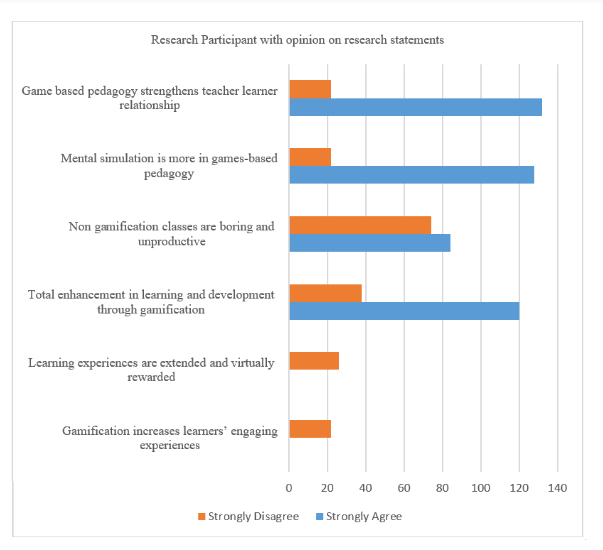
2. Student Engagement and Regularity Analysis
It was implemented in an institute where students were not compelled to attend. With the help of a gamified framework, students were intrinsically motivated to attend classes that included a coin-based attendance system, fun-based learning, online quizzes, and verbal discussions. Enhancement in attendance can be examined in all six sections, as presented in Figure.
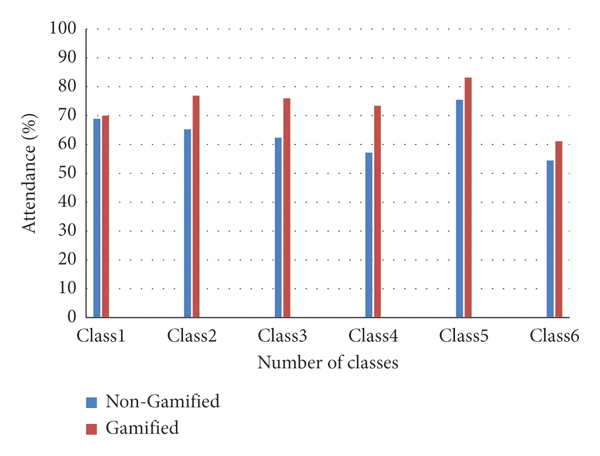
3. Enhanced Collaboration
4. Personalised Learning
Effects of education gamification Using a 5-point scale,
The research sampling unit was asked to react to various items designed to determine their beliefs and viewpoints about the effects of Education Gamification, as shown in Table 1
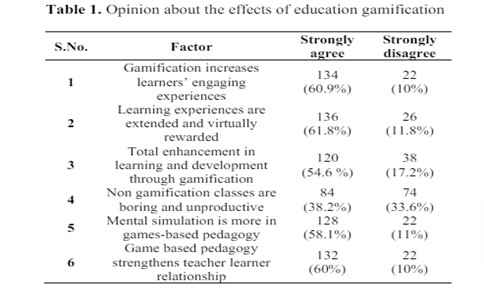
Solution:
Implementing Gamified Activities:
Gamification enables educators to set concrete learning targets and achievements to ensure learners experience a systematic and fun learning process. It guarantees the compatibility of game elements with academic performance and goal achievement, replacing mere entertainment with valuable learning experiences.
Utilising Technology
Educators can use progressive assessment tools such as the leaderboard, badges, and achievements. These tools make it easier for students to monitor their progress, remain motivated, and work harder to enhance their skills.
Creating Immersive Learning Environments
Timely feedback that provides positive encouragement and correction as soon as a misunderstanding occurs. These quick assessments are very valuable for increasing the level of knowledge and motivating students to develop better performance.
Embracing Collaboration
Presents friendly confrontation through the utilisation of challenges and quizzes. This competitive element is, therefore, one of the biggest drivers of student engagement and pushes them to the highest level academically.
Conclusion
Introducing a completely new approach to academic engagement, gamification is a revolutionary method that has transformed higher learning into an enlightened terrain. This blog aims to explore the potential of integrating certain aspects of games into education in order to improve learners' outcomes and interests.
In this area, Singhania Quest Plus enters as a pioneer with tools that involve training for educators who seek to adopt gamification in their teaching. These training and professional development programs ensure that tutors are equipped with all the necessary tools and techniques to help implement the gamified elements into their programs.
External Links for reference
1) https://www.edutopia.org/article/4-tips-getting-started-gamification
2) https://www.hindawi.com/journals/mpe/2021/9922775
FAQs
In the fast-paced world we live in today, getting good grades is no longer the be-all and end-all of student success. Increasingly, education experts recognise the importance of social-emotional learning (SEL) as a vital component of a well-rounded education. But what exactly is SEL, and why should it matter to school leaders and teachers? Let's take a closer look.
What is Social-Emotional Learning?
SEL refers to developing critical life skills that allow students to understand and manage their emotions, build positive relationships, and make responsible decisions. It encompasses five core competencies of Social-Emotional Learning:
1. Self-Awareness: This involves the ability to recognise and understand one's own emotions, strengths, and limitations. It's about being in tune with your inner world, acknowledging your feelings, recognising your areas of proficiency, and being aware of your personal boundaries and constraints.
2. Self-Management: This entails effectively regulating emotions, behaviours, and impulses. It involves managing one's reactions to situations, controlling impulses, and adapting to changing circumstances constructively. Self-management also encompasses techniques for stress management and self-discipline.
3. Social Awareness encompasses understanding different perspectives, empathizing with others, and appreciating diversity. It involves being attuned to the emotions and needs of others, recognizing social cues, and understanding the dynamics of various social situations. Social awareness also consists of valuing and respecting differences in culture, background, and beliefs.
4. Relationship Skills involve communicating clearly, building healthy relationships, and resolving conflicts effectively. They are about expressing oneself articulately, listening actively to others, and fostering meaningful connections. Relationship skills also include the ability to navigate disagreements and conflicts constructively and find mutually beneficial solutions.
5. Responsible Decision-Making: This entails making ethical choices while considering the impacts on oneself and others. It involves weighing the consequences of different options, considering moral and ethical principles, and making decisions that align with one's values and principles. Responsible decision-making also involves being accountable for one's actions and taking responsibility for the outcomes of one's choices.
The Importance of Social-emotional Learning Skills
Numerous research studies highlight the wide-ranging benefits that strong social-emotional competencies can provide students:
Better Academic Performance - Students who can regulate their emotions and stay focused tend to achieve higher grades and test scores.
Positive School Climate - Strong social connections, empathy, and emotional intelligence contribute to more respectful, inclusive learning environments.
Reduced Behavior Issues - By developing self-control, problem-solving abilities, and conflict-resolution skills, students are less likely to act out or cause disruptions.
Improved Mental Health - SEL equips students with strategies to cope with stress, anxiety, and depression in a healthy manner.
Lifelong Success - The communication, collaboration, and emotional intelligence skills gained through SEL programs are essential for success in higher education, careers, and personal relationships.
Bringing Social-emotional Learning to Your School
Integrating comprehensive SEL instruction doesn't necessitate throwing out your existing curriculum. School leaders and teachers can take the following steps:
Prioritize Professional Development - Provide training to equip your instructors with the knowledge and skills to effectively model and teach SEL competencies.
Embed SEL School-Wide - Look for opportunities to reinforce SEL skills across academic subjects, school programs, extracurricular activities, and institutional practices.
Leverage Technology Tools - Explore educational technology platforms and apps that offer engaging, multimedia activities aligned with SEL learning objectives.
Engage Families & Communities - Collaborate with parents and community organizations to promote SEL concepts beyond the classroom walls.
By prioritizing students' social-emotional development alongside academics, schools can nurture well-rounded individuals prepared for success. An education steeped in SEL gives children the skills to not only achieve in school but also flourish as adults, able to forge healthy relationships, manage adversity, and lead purposeful lives. In today's world, that's an investment worth making.
The National Education Policy (NEP) 2020 is a path-breaking educational policy that aims to transform the education system through schools in India. Under the NEP guidelines, it is essential for schools to adopt and implement quality and technology-integrated teaching methods, helping facilitate the academic growth of students.
About the NEP 2020:
India's National Education Policy 2020 marks a significant milestone in the country’s education system, aiming to transform it into a dynamic, inclusive, and holistic learning environment. This policy, formulated after three decades, seeks to address the evolving needs of learners, promote skill development, and foster innovation in education. In this blog, we will delve into the key highlights of India's National Education Policy 2020 and explore the potential impact it holds for students, educators, and the nation as a whole.
The National Education Policy 2020 also emphasises the integration of technology in education. The policy promotes a holistic teaching approach with technology-integrated video lessons in alignment with the NEP 2020. This helps schools implement blended teaching-learning methods in their classrooms. The holistic and multidisciplinary learning methods promoted by the NEP aim to upgrade education in schools through the latest trends and learning technologies, equipping students with 21st-century skills needed to succeed in today's digital world.
Key highlights of the NEP 2020:
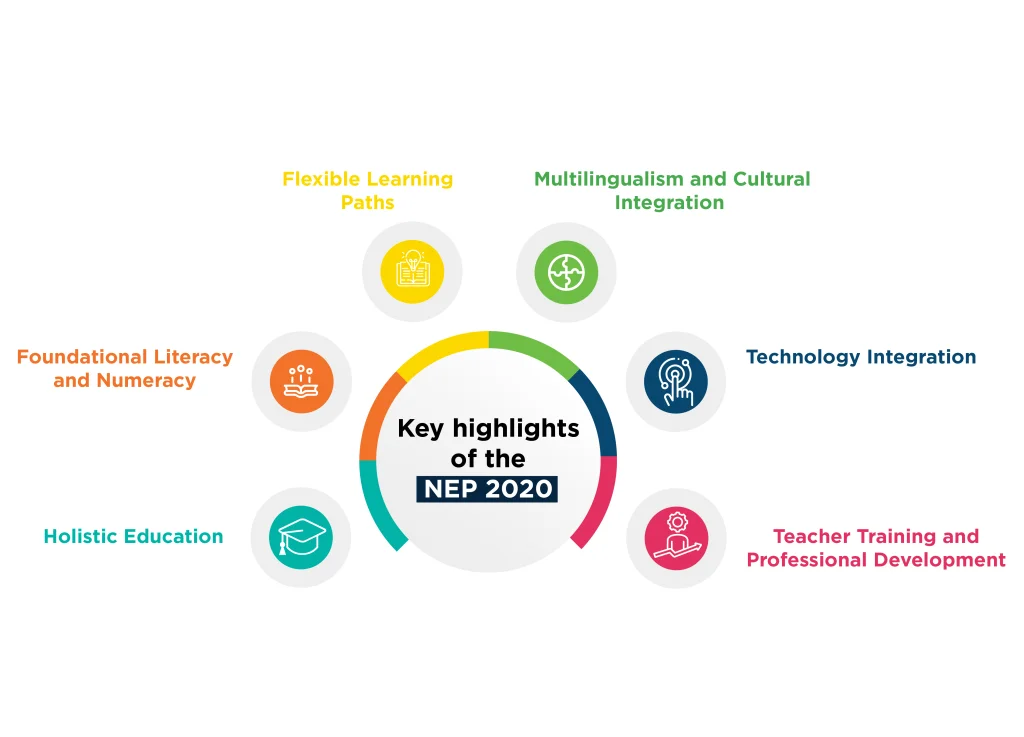
The NEP 2020 sets forth a vision for transforming the Indian education system, focusing on quality, accessibility, equity, and lifelong learning. Its implementation helps bring about comprehensive reforms in education across the country.
1. Holistic Education:
The National Education Policy 2020 emphasises a shift from traditional rote learning to a holistic learning approach. It encourages teachers to develop critical thinking, problem-solving, creativity, and communication skills in students. The policy promotes a multidisciplinary approach, allowing teachers to explore diverse teaching methods encouraging the integration of arts, sports, and vocational education.
2. Foundational Literacy and Numeracy:
Recognising the importance of strong foundational skills, the policy places emphasis on early childhood care and education. It aims to ensure that schools provide every child necessary basic literacy and numeracy skills by the third grade. This focus on foundational learning forms the bedrock for subsequent educational achievements.
3. Flexible Learning Paths:
The policy acknowledges the unique abilities and interests of students and emphasises the need for flexible learning paths. It introduces a 5+3+3+4 academic structure, replacing the traditional 10+2 educational system, with the aim of providing a more holistic and flexible education structure. This structure adds pre-primary education under the umbrella of formal education. The policy also encourages vocational education from an early age to help teachers equip students with practical skills.
4. Multilingualism and Cultural Integration:
Recognising the linguistic and cultural diversity of India, the policy emphasises multilingualism during students’ foundational years. It encourages the teaching and learning of multiple languages, including regional languages, to preserve and promote cultural diversity. This helps students learn in their regional language, helping them understand concepts more effectively.
5. Technology Integration:
The National Education Policy 2020 recognises the importance of technology in education and encourages its integration into the classroom learning process. The policy aims to enhance teaching and learning experiences by leveraging digital tools, online resources, and e-learning platforms. The integration of technology is expected to facilitate personalised learning, provide access to quality education in remote areas, and improve the overall efficiency of the education system.
6. Teacher Training and Professional Development:
The policy recognises the crucial role of teachers in shaping the future of education. It emphasises the need for continuous professional development, fostering a supportive and conducive environment for teachers. The policy also encourages the use of technology for teacher training and provides opportunities for career advancement.
NEP 2020 as a transformative educational reform:
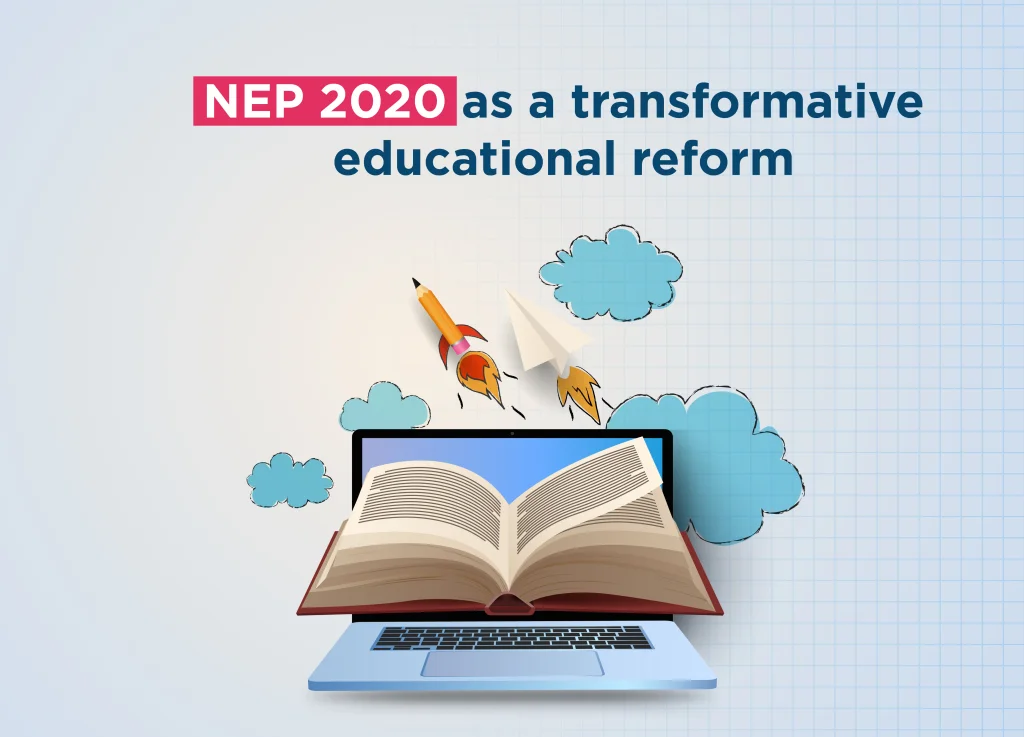
India's National Education Policy 2020 sets forth a visionary roadmap for transforming the country's education system. With its emphasis on holistic learning, flexible pathways, technology integration, and teacher development, the policy seeks to equip learners with the skills and knowledge necessary to excel in the 21st century. Emphasis is also laid on the integration of technology in education, along with reforms in professional development for teachers.
The NEP 2020 aims to bring about the following changes in education:
- Multidisciplinary and holistic education
- Good school education structure
- Promote digital literacy
- Implement blended teaching-learning practices
- Provide equal learning opportunities
- Lay emphasis on professional development
Overall, the National Education Policy 2020 aims to transform the Indian education system by empowering schools with 21st-century teaching-learning solutions, helping teachers foster the holistic development and academic growth of their students, and preparing them to be leaders in the future. Embracing the key highlights of this policy will give schools the potential to nurture a generation of empowered individuals capable of driving social, economic, and technological progress.
In the rapidly evolving landscape of education, technology has brought about transformative changes in the way knowledge is imparted and received. The integration of technology in education, as highlighted by the National Education Policy 2020 (NEP 2020), has paved the way for dynamic and interactive classroom teaching-learning processes. A key transformation in education is the incorporation of video lessons in classrooms, helping revolutionise traditional classroom dynamics and providing teachers with a new approach to teaching. In this blog, we will delve into the pivotal role of video lessons in enhancing 21st-century classroom learning.
Transforming Teaching Approaches in the Classroom:
The paradigm shift from conventional teaching methods to a more modern, technology-infused approach has played a major role in reshaping the classroom atmosphere. With the implementation of smart boards and offline lesson content, teachers are now equipped with powerful classroom teaching tools, helping them provide quality instruction in the classroom. These tools, coupled with online education platforms, facilitate interactive and engaging classroom teaching with video lessons tailored to specific academic subjects. This has given rise to learning with video lessons in schools, which align seamlessly with the concept of blended learning, combining the best of traditional and 21st-century education, thus fostering a concept-based teaching structure.
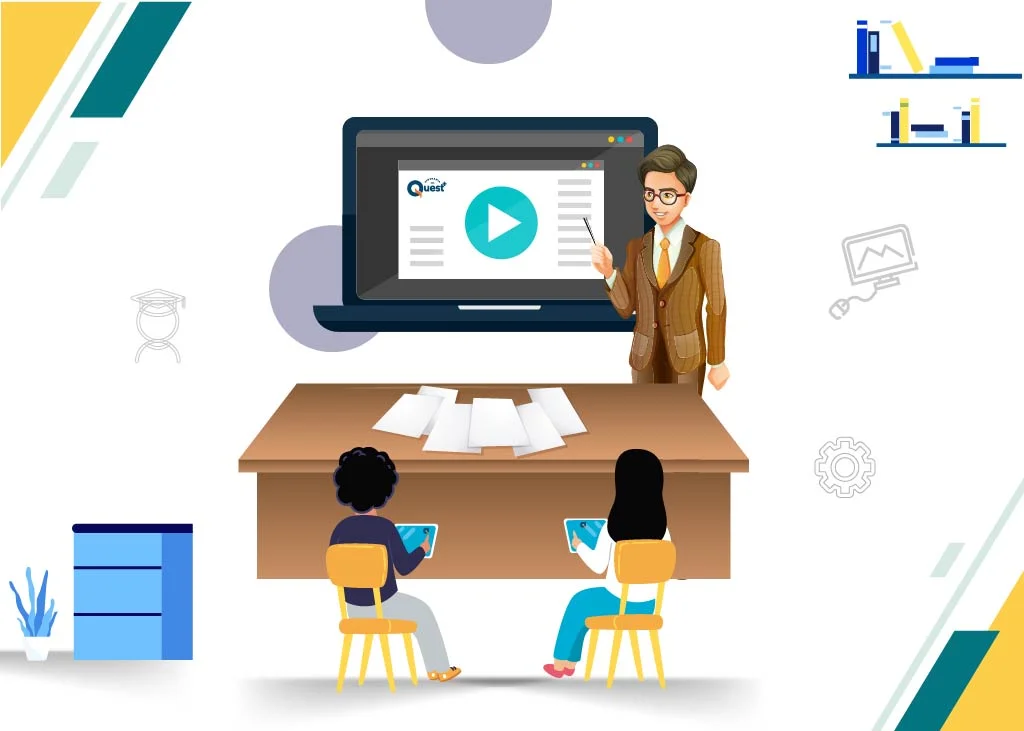
Need for Technology Integration with Video Lessons:
The need for technology integration in our classrooms cannot be overstated. The fast-paced digital era demands innovative teaching strategies to captivate the attention of students and provide an engaging learning experience. Video lessons serve as a bridge between diverse teaching-learning preferences. In today's education industry, where schools’ partnerships with online learning platforms are flourishing, video lessons stand out as a versatile teaching tool catering to diverse learning styles. Through visually stimulating and engaging content, complex concepts are broken down, promoting conceptual understanding and clarity among students.
How Video Lessons Help Increase Teaching Efficiency in the Classroom:
One of the primary advantages of incorporating video lessons into classroom teaching methods is in the enhancement of teaching efficiency. Teachers can curate or access a vast repository of educational videos tailored to their curriculum. These videos serve as ready-made teaching modules, saving valuable time in lesson planning and ensuring consistent quality of subject content.
Here are the ways in which video lessons enhance classroom teaching:
- Video lessons display information in multiple formats.
- They are flexible and can be changed as per curriculum changes.
- Help teachers hold students’ attention for longer periods of time.
- Provide teachers with a content library to refer to.
- Simplify complex topics with captivating visuals.
Moreover, teachers can utilise their lecture period more effectively by engaging students in discussions, helping foster critical thinking and problem-solving skills among them rather than spending excessive time explaining fundamental concepts. Video lessons also provide teachers with the support required to enhance classroom teaching, helping take subject content delivery to the next level.
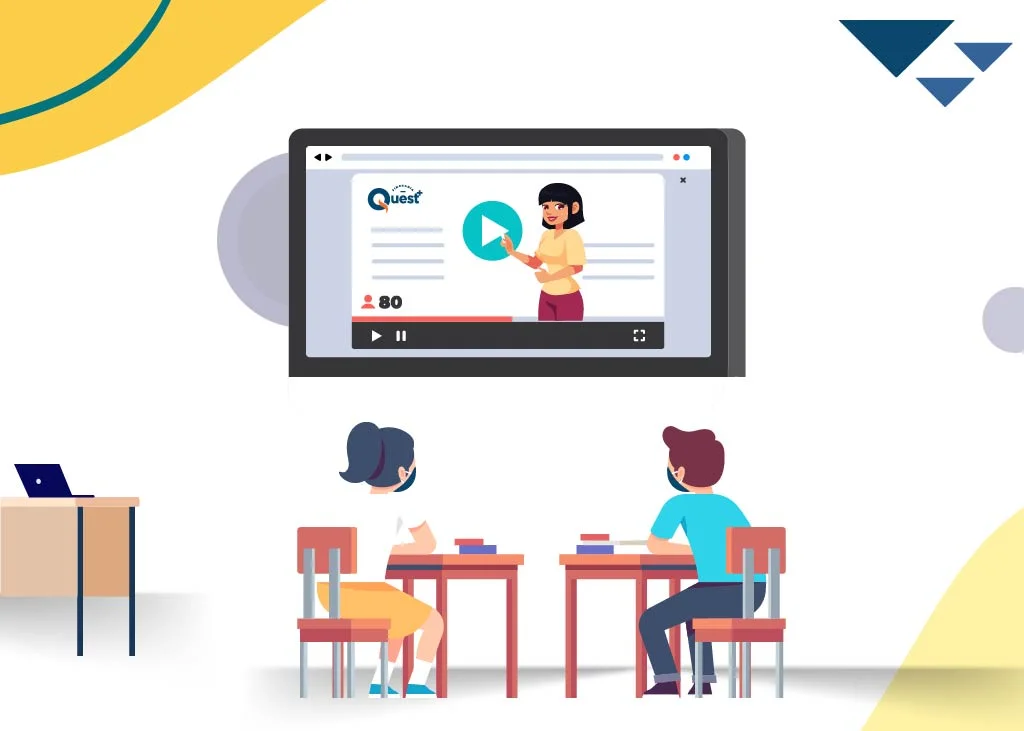
Advantages of Video Lessons in Schools’ teaching-learning processes:
Video lessons offer a myriad of benefits in the teaching-learning process. Schools aim to provide an enhanced learning experience through video lessons, giving students a better understanding of concepts and serving as a good opportunity for school teachers to teach and revise complex chapters. This helps schools ensure that students with varying academic abilities grasp the study material effectively.
Here’s how video lessons benefit schools' academic programs:
- Helps schools integrate technology into academics.
- Demonstrates schools’ goal of providing quality education.
- Highlight quality teaching methods implemented.
- They act as a professional development tool for teachers.
- Highlights schools’ unique educational initiatives.
In addition, interactive and engaging videos stimulate the minds of students, encouraging active participation in the classroom and facilitating knowledge retention. Video lessons allow teachers to revisit challenging topics and reinforce students’ understanding at their own convenience. This distinguishes video lessons from traditional teaching methods, making it a better option for classroom learning in schools.

Embracing video lessons as a part of the future of education:
Video lessons as a part of classroom learning have helped schools take a significant leap forward in education. As school principals and teachers navigate the educational trends and updates of the 21st century, it is imperative for them to harness the power of technology in education. Video lessons, as an essential component of the hybrid learning environment, not only enhance academic outcomes but also nurture vital skills such as critical thinking and problem-solving in students. By embracing these advancements, educators can create dynamic, interactive, and intellectually stimulating classrooms that prepare students for the challenges and opportunities of the future. With the future of classroom learning being digital, engaging, and transformative, it is up to the teachers to empower students with the best learning tools available, shaping a generation of lifelong learners ready to lead the future.
In an era driven by technological advancements, teaching-learning methods in schools have improved not only physically, but digitally as well. Recent educational policies like the NEP 2020, focused on the holistic growth of students have made it imperative for schools to equip their students with 21st century skills, necessary to thrive in this digital landscape. The National Education Policy 2020 (NEP 2020) recognizes the significance of coding and skill development as a part of the school curriculum, developing approaches that integrate 21st-century skills into the curriculum. In light of this, coding in schools emerges as a key requirement in helping teachers promote cognitive development, critical thinking, and digital literacy in the classroom, thereby shaping future-ready students. Let's delve into the importance and benefits of coding in schools.
The Importance of Coding for Schools
With the rapid advancements in digital learning, there are a number of reasons why schools should teach coding. The primary factor is the integration of coding education, which has gained paramount importance in recent years. Coding in 21st century education isn't just about mastering computer languages; but about helping teachers foster computational thinking and problem-solving skills in the classroom. With emphasis given to experiential learning, schools need to focus on the skill development of students, aiding in the expansion of their skill-set and facilitating their overall growth and development.
Coding has become a necessary requirement in schools as:
- Coding has become an integral part of schools’ curricula
- Helps schools abide by educational policy guidelines
- It provides a transformative approach to classroom learning
- It promotes experiential learning in schools
The NEP 2020 recognizes coding as more than just a technical skill. It is a catalyst for cognitive development. Coding is important for students as it promotes experiential learning, where they learn by doing, fostering a deeper understanding of concepts taught in the classroom. This is a hands-on approach that helps schools transform passive learners into active problem solvers, enhancing schools’ curricula and taking it to a higher level.

How Coding Enhances Schools' Curricula
A good school is one that aligns its curriculum with the evolving changes in education. Coding is a powerful enhancer for a school’s curriculum, bridging the gap between theoretical knowledge and practical application. Incorporating coding into a school’s curriculum helps educators foster a deep connection between concepts taught in class and real-world scenarios. Moreover, project-based learning through coding has become an increasingly implemented method of the classroom teaching-learning process.
Coding enhances schools’ curricula by:
- Introducing digital learning tools and platforms
- Facilitating cross-disciplinary learning
- Increasing technological literacy
- Differentiating schools as leaders in education
By introducing coding as part of the curriculum, schools can infuse experiential learning into their educational approach, making the classroom teaching-learning process more engaging and relevant.
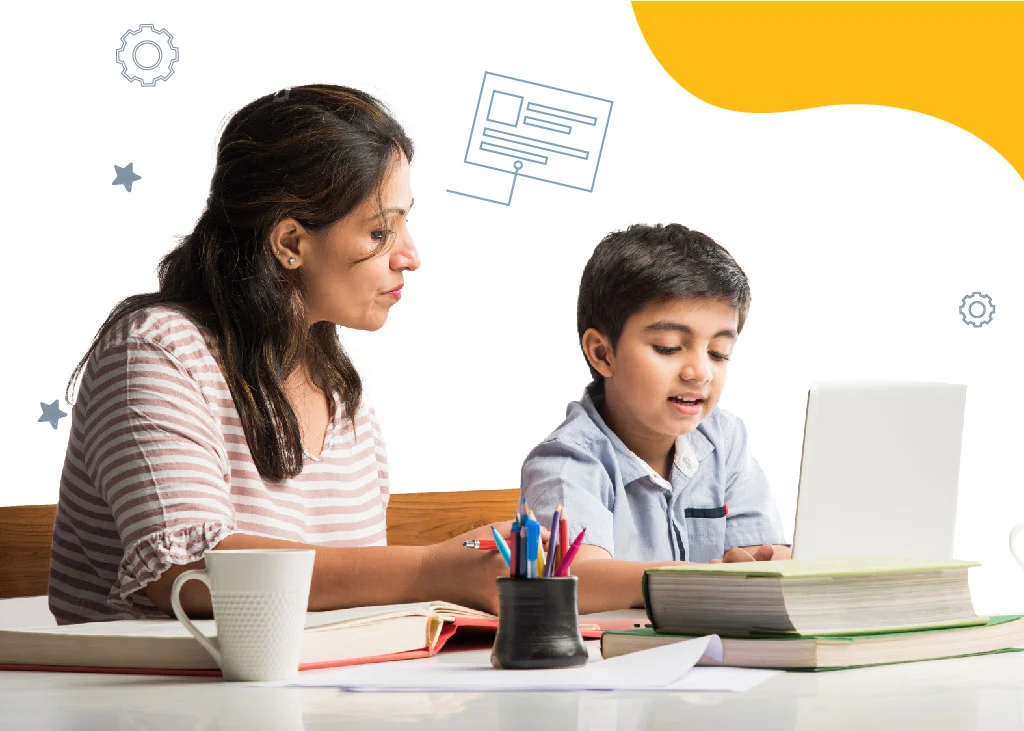
How Coding Helps Teachers Promote Digital Literacy in the Classroom
The question of ‘Why teachers need to learn coding’ is often asked when it comes to subjects related to computers and skill development. Digital familiarity is an imperative facet of the modern world, and teachers have a pivotal role in guiding students towards becoming digitally literate in the classroom. Teachers who learn coding can leverage technology to cultivate a comprehensive understanding of digital tools and platforms in the classroom, enabling and encouraging students to think critically and logically and helping them integrate coding and digital tools seamlessly into other academic subjects and real-world scenarios.
Coding helps teachers:
- Promote skill development in students
- Bring about the cross-curricular integration of subjects
- Enhance problem-solving and computational skills of students
- Promote 21st century skills in the classroom
With the help of coding, teachers can create a dynamic learning environment using quality teaching methods that nurtures 21st-century skills. Coding is not a single subject but an entry point to develop a range of proficiencies such as problem-solving, critical thinking, and collaboration. By using coding as a means to promote digital literacy in the classroom, teachers can develop 21st century skills in students and lay the foundation for them to excel in an increasingly digital world.

Benefits of Coding for Students and Teachers
The benefits of coding extend to both students and teachers alike. For students, coding equips them with 21st century skills that are not only relevant in today's digital age but are a necessity to excel in education and provide a competitive edge in future career opportunities. Coding nurtures computational thinking, which is an essential skill for overcoming complex problems and devising innovative solutions to any challenges.
Benefits of coding:
- Facilitates experiential learning
- Creates an engaging and interactive classroom
- Creates better job opportunities
- Boosts critical thinking and problem-solving skills
It's not only students who benefit from coding and skill development. Teachers also stand to gain from coding and programming. Through proper professional development and training in coding and development programs, teachers can incorporate coding into their teaching methodologies, enriching their classrooms with technology-integrated learning experiences. This, in turn, enhances the overall quality of teaching and education in schools.
Summary of the Importance and Benefits of Coding in Schools
In conclusion, coding isn't just about writing lines of code; it's about shaping the minds of future leaders. In the backdrop of NEP 2020, coding education has emerged as a cornerstone for skill development, computational thinking, and digital literacy. As schools endeavour to become NEP-ready institutions, coding plays an indispensable role in nurturing holistic development and 21st-century skills among students.
By integrating coding into the curriculum, schools empower students to become proactive learners who can decipher complex problems and create innovative solutions. Moreover, coding-driven education equips teachers with modern teaching methodologies, fostering a dynamic learning environment that caters to the needs of the ever-evolving digital landscape.
Schools understand that coding isn't just an educational trend; it's a pathway to prepare students for the challenges and opportunities of the future. As we move forward in the age of technology, coding education stands as a testament to the power of knowledge, innovation, and adaptability, that are at the core of education in NEP-ready schools.
